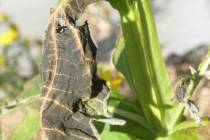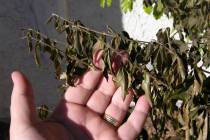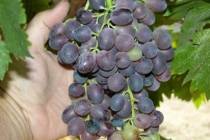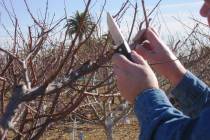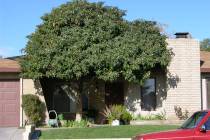If you have fruit trees, the next big tree management activity you are facing is fruit thinning or removing excessive amounts of fruit so that the remaining fruit gets larger. Peaches, nectarines, plums, apples and pears must have excessive fruit removed if you want larger fruit. Do this as soon as the fruit reaches the size of your thumbnail.
- Home
- >> Local
- >> Local Columns
Bob Morris
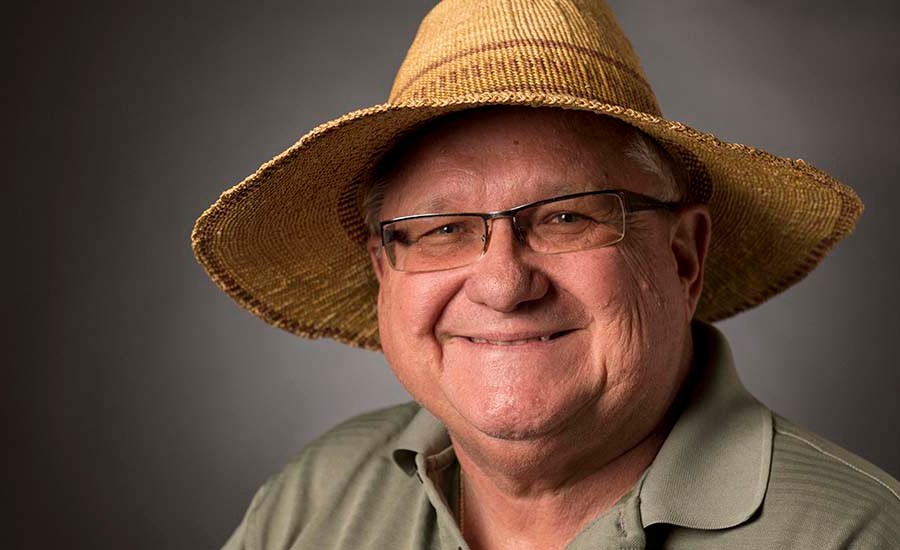
Bob Morris is a horticulture expert living in Las Vegas and professor emeritus for the University of Nevada. Visit his blog at xtremehorticulture.blogspot.com. Send questions to Extremehort@aol.com.
Q: What do you recommend for controlling that ugly, leaf-footed bug that attacks my pomegranates? I want to be prepared.
Q: Peaches from my dwarf peach tree were very small again last year. This is the third year the fruit developed into a small size. We fertilize them twice a year with vegetable spikes and our in-ground system fertilizer system has Dr. Benson’s Natural Mix added five times per year. Any suggestions?
Q: I have some tomatoes and pepper plants in pots. They are about 18 inches tall. Is it too early to plant them in my raised bed garden? It’s been too cold lately to plant.
Q: I am from San Miguel Community Garden, a nonprofit garden located near the North Las Vegas Airport. We are considering adding more grape plants to the garden. We have Flaming Red and Thompson grapes. You said you have grown many different varieties in the Las Vegas Valley, and I was wondering if you would share with me other varieties that were successful for you so we can explore them as well.
Many people contacted me about whether they could plant seeds or put transplants into the ground because of this unusually cold weather. My answer was the same to them as it is here. It depends.
Q: I want to propagate my prickly pear and bunny ear cactus. Should I place the cuttings immediately in the ground or in a pot and plant them in the ground later?
Another freeze went through the valley this past week along with some unusually cold weather. Freezing temperatures are more damaging to plants as we enter the spring months because plants are starting to wake up from their winter dormant period. These same plants might have no problems with these temperatures in December and January.
Can an old, neglected grapevine be revived? Horticulture expert Bob Morris answers that question and more.
Maybe gardeners aren’t busy in Minnesota or Iowa during the winter, but for gardeners living in the Mojave Desert, it is probably our busiest time of year. I’m asked about spraying dormant oils on trees, but most people don’t know anything about them. It’s a shame because it’s probably the most important method to control bugs that may become problems during the coming year. It’s good insurance.
Q: I planted a Bosc pear tree seven years ago not realizing it required a second pollenizer pear tree. For several years, I did get a few pears even though the tree had lots of flowers. I think my neighbor’s pear tree was the pollenizer, but it seems to be failing. I have no room to plant a pollenizer pear tree. Not sure what to do.
Q: I recently installed an underground fertilizer injector, and I was told to discontinue fertilizing by hand. Does this injector replace fertilizing plants by hand? Is it beneficial as a supplement? If so, how often should it be used?
I know readers will be asking why their lemon or grapefruit did not produce any fruit this year. They will say, “The tree grew great, but it didn’t produce any fruit.”
Q: We are moving to a new house and want to plant a row of trees by the fence for privacy and security. A local nursery suggested Carolina cherry and Japanese privet, but we heard these trees will not do well in this climate. Another suggestion was the African sumac. What would you suggest? We want evergreen for privacy.
Q: Around town and in my neighborhood, many midlife trees are dying. In beautiful large trees, there are dead branches and sometimes just a fully dead tree. Some trees are planted in gravel and some in a yard. Do you notice that also?








